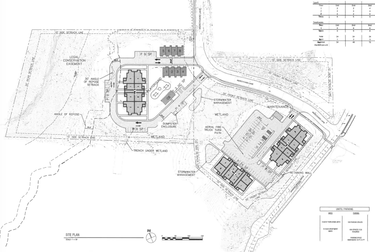Mercy Care Lane proposal for affordable and workforce housing proceeds
GUILDERLAND — A proposal to build a complex on Mercy Care Lane with 72 units of affordable and workforce housing cleared another hurdle on Aug. 19 as the Guilderland Town Board unanimously agreed the density was appropriate to proceed.
The 72 units are to be built on 10.7 acres, which works out to less than seven units per acre, according to P. Christopher Dirr, a principal with Rockabill Consulting, the developer.
Supervisor Peter Barber noted that the town’s maximum density is 12 units per acre.
Laurel Bohl, a lawyer and former Guilderland Town Board member who owns property adjacent to the proposed project site, shared her concerns with the board.
While Bohl said she is “very much in favor of affordable housing,” she was concerned about the height of the proposed buildings as well as the density.
Beacon Meadows, one of several groups that had abandoned earlier plans for the site, had proposed more cottage-style homes, which Bohl found more appropriate.
The Rockabill plan features 3-story buildings that are 41 feet tall, which Bohl called “way out of place” in the neighborhood. Underlying zoning caps the height at 35 feet.
“It’ll feel like it’s sitting on my lawn, which is a huge impact on where I’ve lived and my family has lived all my life,” said Bohl.
Bohl cautioned the board, “I don’t think they should be given the sky’s the limit from the town board, which going up to 41 feet is pretty much that."
Bohl urged a continuance on the board vote.
Dirr responded that the Beacon Meadows project was “spread out further on the site” and that the current plan conserves open space. “In constricting the site, we were looking to leave more land to the rear of the site …,” Dirr told Bohl, “creating a greater distance between the developed area of our site and your yard.”
The buildings, he said, will also be further from a ravine on the property.
As to height, he said, a pitched-roof design accounts for a lot of the height. “We could certainly reduce the building height by going to a flat roof,” he said.
Building height, he said, would evolve during the planning board process and, once that process is underway, there would be “dialog” with Bohl and other neighbors.
“We are not setting the building height,” said Barber. “We’re not giving any permission for anything.”
“Nor are we looking for that this evening,” responded Dirr.
Barber stressed figures from a memo the town planner, Kenneth Kovalchik, had sent to the board: 80 percent of the units will be “affordable housing,” leased to households earning 30 to 60 percent of the area median income, while the remaining 20 percent, known as “workforce housing,” will be leased to households earning 80 percent of the area median income.
In Guilderland, this means households in the development will earn $30,000 to $90,000 annually.
In June, the town board voted, again unanimously, to grant an exception to its building moratorium in order to allow the planned unit development to proceed.
Dirr said at that time that the project on Mercy Care Lane would depend on funding from the state’s Homes and Community Renewal agency, which has an application deadline in the fall.
The project will now return to the town’s planning board.
“This just allows them to dig deeper,” said Councilwoman Amanda Beedle of moving to the next step.
“He goes to the planning board after this, comes back to us, and then goes back to the planning board again,” said Barber. “It’s a yo-yo back and forth.”
Rezones
On Aug. 19, the board also granted, by unanimous vote and without discussion, two rezones for two separate Route 20 businesses. In both cases, the designation was changed from Business Non-Retail Professional to a Local Business district
The town planner and planning board reviewed and supported the changes for each while the county’s planning board said it would defer to local consideration in both cases.
Kovalchik told The Enterprise earlier, “The BNRP District is heavily weighted towards smaller office uses and the demand for office space has declined significantly since the pandemic.”
Jennifer McClaine, who runs a beauty salon from her 3.8-acre parcel at 2093 Western Ave., wanted the rezone so she could rent to other businesses.
Christopher Laviano wanted the rezone for two adjacent parcels — totalling just 0.31 acres — at 1859 and 1865 Western Ave. because a plaza he built had different zoning for the same structure.
Barber on Tuesday said the local laws are “very simple” with “no conditions.” He went on, “I don't like conditional rezones. They are what they are.”



